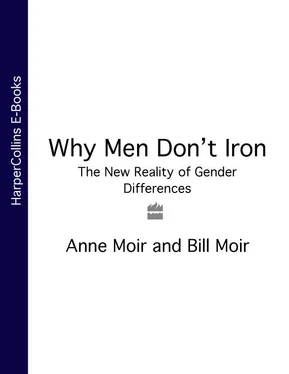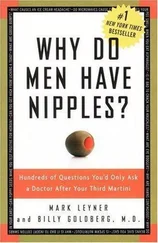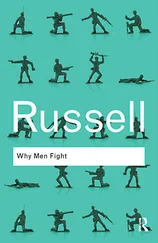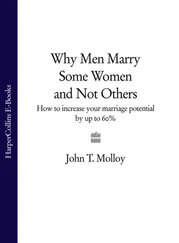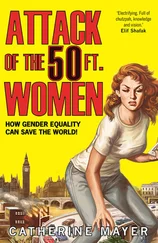‘In the social sciences,’ says Bill, ‘there is too often a presumption against things that are not socially conctructed.’
‘But,’ says Anne, ‘there are other, harder sciences that show real sex differences.’
‘Hmm …’ says Bill. ‘Then in exploring the new science of gender differences we also explore the limits of social theory and its capacity to transform the sexes.’
If (and it is a big IF) gender is socially conditioned, then it must be true that it can be socially unconditioned and that sexual roles can be unlearned. In part this is true, inasmuch as the male who stamps his views on women can learn to recognize the existence of another mind (and vice versa). What then of the view that the sexes are alike, but the male can never be wholly deconstructed because he lacks the female experience? He cannot experience the menses, birthing or lactation. Trivialities, says the feminist. Failure to experience such physical processes does not affect the male’s ability to embrace and adopt feminine virtues: peace, co-operation, holistic dreams. The time when the lion will lie down with the lamb or, even better, the lioness. How much the world would be improved if only they, men, were more like women.
When the communicators of our society (the academy and the media) fail to get a grip on a subject – fail, that is, to understand what they are supposed to be explaining – the failure is often depicted as a deeper form of understanding. It is presented as a kind of wry humility, summed up by the adage ‘the more we know the less we know’. Lack of understanding is taken as a virtue instead of a failing. It seems that one cannot be sure about anything except the advantages of not knowing. It is the postmodern understanding; and, perhaps, the foxhole for the spooked and lost in every generation.
Postmodernists have no answers (answers are unambiguous, and unambiguity is bad), and that is the problem. They confront certainty with the question, ‘How can you be so sure?’ It is a useful logic for unsettling coherence (and is used not only by postmodern academics but also by neo-Nazis in their rejection of the existence of the Holocaust). It also advances all the frontiers of ignorance.
This postmodern ‘understanding’ rides in tandem with a common female approach to the world in general, an approach that is non-confrontational, non-judgemental, unaligned and multi-cultural. The past is seen as having been defined by male certainties, summed up in the dismissive acronym DWEM, which defines and rejects the philosophy, art, literature and cultural assumptions bequeathed to us by Dead White European Males. The old canon – that body of knowledge which was thought essential to an understanding of our culture – has been dismissed by many parts of the academy. To claim that Shakespeare is a greater writer than, say, some previously unknown woman is to be elitist. Thus we witness the feminization of the academy.
What is fixed is decreed authoritarian. What is authoritarian is male. What is male is bad.
We move from a time of sharply drawn lines to a time where the line drawn is against the drawing of lines. Fifty years ago a man was expected to play the dominant role; expected, if successful, to provide for his wife and children. Today the great expectation is of a sexual parity at home and at work, in the ways we relax and in the games we play, in our learning and in our parenting. Lines of demarcation, present for millennia, are being blurred.
The traditional male draws lines too tight, with himself as the norm. Postmodernism denies the existence of any lines, yet to deny the existence of the major sexual differences (always done, of course, in the name of toleration) is to play the most dangerous gender game. Those who believe that our differences are all culturally caused wish to eradicate those differences. Their burning ideology is to eliminate the distinct in society. There are historical antecedents, rooted in the conviction that we are all one; if you disagreed you were placed beyond the pale, and beyond the pale lay the cleansing fire with its waiting stake.
‘Failing to draw the line,’ says Anne, ‘they give equal voice to the absurd.’
‘Which is to say themselves,’ says Bill.
The new orthodoxy claims that there is no distinctive male mind – nor, indeed, a distinctive female mind. The old demarcation between him and her has been replaced with a muddling whirl of complex and shifting social assumptions. 11A reverence for equity in all things has dulled the critical faculties. ‘You can’t generalize about people.’ ‘You mustn’t stereotype people.’ ‘All generalizations are misleading [except, of course, this one].’ ‘We are all different’ [a safely vacuous remark to which is often added] ‘but not that different’ – which is to collapse meaning. Such claims are good ways to paper over cracks; but they hardly lead to understanding.
Return, for a moment, to the postmodern ideal of a man. He rejects the old traditional male assumptions, preferring to recognize the existence within himself of female virtues: co-operation, tolerance, non-judgementalism and an instinctive acceptance of equality (meaning sameness). O brave new world, that has such creatures in it. Get rid of the artificial lines and how the barriers will fall! There will be no more ‘glass ceiling’ (the barrier traditional males erect against female success), no more ‘homophobia’ (the barrier which encourages heterosexual males to treat gays as lesser beings). The lion, lioness and lamb are all one.
But suppose this postmodern ideal is wrong. Not morally wrong, but scientifically wrong. Suppose, perish the thought, that there are lines, not drawn by society but etched by blind, uncontrollable nature. Lines as ineradicable as the leopard’s spots. Lines drawn by biological forces.
That is the subject of this book, which attempts to explain the findings of current scientific research into gender differences. The assumption of the book is not that ‘we are all the same’, but rather that we are distinctly different. That to be a man is not to be an inferior version of a woman, nor a better version, but to be what nature intended. This is not to say that a man (or woman) cannot change, but it is to claim that there are constant masculine values. The postmodernists want men to change, to become, indeed, more like women; when men constantly fail to live up to their expectations it should be allowed that the expectations themselves might be false, and here science can be of assistance.
Science can help because it sets certain limits to the probable. Like an accurate record of the past (postmodernists, of course, claim that no such thing is possible), science is a benchmark as to what is improbable. Science offers a large measure of explanatory power. The probabilities of science, like the events of the past, are impervious to the human will. You might wish the earth were the centre of the universe, but blowing out every last birthday candle will not make the sun revolve about the earth. You might wish men and women to be the same, but the scientific evidence suggests your wishes are fantasies. Men and women possess different neural nets, hormonal systems and neurotransmitters – splendid differences that make the sexes distinct.
A discrete body of knowledge is building up. Evidence is being brought together from mainstream science – from psychology, psychiatry, neurophysiology, endocrinology – and the sum of the evidence suggests that men and women are different. It does not suggest that one is better than the other, it makes no claims for ‘equality’, it simply describes the differences. To understand those differences is to understand each other. Mutual respect can only be based on a clear-eyed acceptance of sexual difference; not on their denial. To insist on sexual sameness – to be blind to male, female or homosexual characteristics – is the sexism of the late 20th-century intellectual. Victorian prudes would be delighted with the postmodern refusal to face up to the physical basis of sexual difference.
Читать дальше
